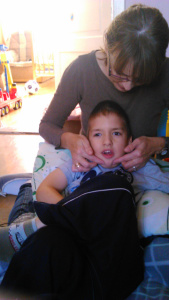Integration of orofacial reflexes according to the method of Dr. Svetlana Masgutova
THE INFLUENCE OF OROFACIAL MOTILITY ON THE DEVELOPMENT OF THE CHILD.
Symptoms of neurophysiological abnormalities that appear already in the first days of the child's life, such as: difficulties related to food intake (the child does not close his mouth, has problems with grasping the breast, sucks incorrectly, swallows, salivates excessively, refuses to eat) are associated with later problems in biting, chewing, using a cup, persistent sucking, constantly open mouth, protruding tongue, which consequently leads to speech disorders. Work
with reflexes is aimed at supporting the correct developmental mechanisms. It allows you to mitigate the effects of greater brain damage.
Facial reflexes, like other reflexes, appear and develop in the prenatal period, and mature
and integrate in infancy. There are reflexes that are active throughout life that function similarly to the controlled movement habits of the face. Both types of reflexes must integrate so that the reflex patterns associated with the functions they are supposed to perform can properly
and function well.
If the integration of orofacial reflexes has not occurred in children and adults, this may cause:
– negative compensations,
– excessive use of too many muscles to perform a task or activity,
– too much muscle tension and rapid fatigue,
– symmetry disorders of the face and the whole body,
– excessive control, hyperactivity,
– poor physical condition,
– emotional instability, disharmony in cognitive processes.
The prerequisite for the development of orofacial motility are primary (automatic), unconscious reactions and reflexes genetically programmed. This is the so-called primary sphere of motor skills. Primary motor skills are the basis for learned motor skills. Primary motility is necessary for human functioning, as it ensures physiological survival, defensive reactions
and forms the basis for the development of learning. At the right time, primary motor skills freely pass (integrate) into learned motility. Non-integrated primary motor skills remain always active, stimulate defensive responses and negatively affect behavior and learning.
Consciously formed (intentional) motor skills are secondary motor skills. We call it higher, controlled, learned. It functions properly when the hindbrain is neurologically mature. In the hindbrain, all reflexes are localized. If the reactions are correct, then it translates into a sense of security, and this into bonding reflexes. Children with disorders develop a reflex to fight, escape, survive or defend, but defense is incorrect to react. Disturbed reflexes in children do not go hand in hand with his physical development. Then they get tired faster, muscle tension is incorrect. The brain does not understand what is being done. Integrated reflexes of the orofacial area make our movements and habits not sudden, impulsive, involuntary, unconditional reflex reactions, but create a base of consciously controlled, planned and at the same time free movements.
Early diagnosis of the child and early comprehensive treatment and rehabilitation due to the plasticity of the central nervous system are very important. It is assumed that the best results are brought by the rehabilitation of the child just after birth up to 3 years of age, because the plasticity is the greatest. Equally important is the regularity of the exercises and the duration of therapy. Through properly selected manual exercises you can get: correct food intake, better facial expression, correct visual and auditory perception, regulation of muscle tone, speech improvement
and the ability to communicate, develop awareness and movement of one's own body.
Facial massage serves the proper nerve conduction, and this leads to the proper functioning of the brain, to integrate primary reflexes with learned ones, to "re-arrange" what is
In fetal life, it was disturbed and helps support the development of normal reaction patterns and orofacial reflexes.
Bibliography:
Masgutowa S., Regner a., (2009). Child's speech development in the light of sensorimotor integration,
Ed. Continuo, Wroclaw


